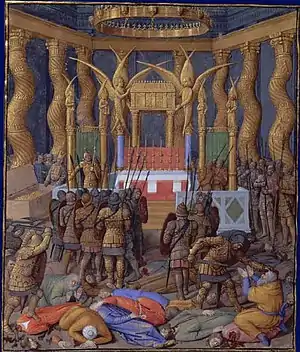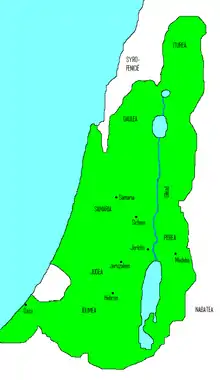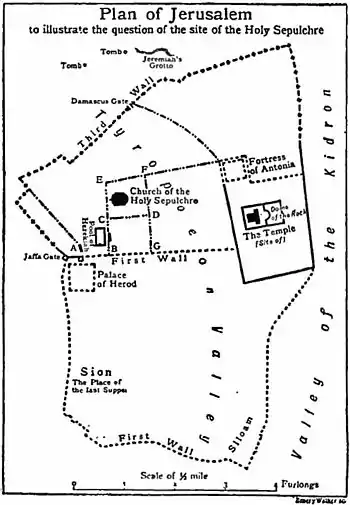Hasmonean Civil War
The Hasmonean Civil War was a civil war between two claimants to the Hasmonean Jewish Crown. What began as an inter-Jewish conflict became a highly decisive conflict that included the Nabataean Kingdom and ended with Roman involvement. This conflict resulted in the loss of Jewish independence.
| Hasmonean Civil War | ||||||||
|---|---|---|---|---|---|---|---|---|
 Pompey in the Temple of Jerusalem, Jean Fouquet (1470-1475) | ||||||||
| ||||||||
| Belligerents | ||||||||
|
Aristobulus supporters: Sadducees Mercenaries |
Hyrcanus supporters: Pharisees Nabataean kingdom |
| ||||||
| Commanders and leaders | ||||||||
|
|
Aretas III |
| ||||||
| Strength | ||||||||
| Unknown |
Unknown number of Hyrcanus loyalists (over 6,000) 50,000 Nabataean infantry and cavalry troops[1] | Unknown | ||||||
| Casualties and losses | ||||||||
| Over 12,000 killed (Including many civilians) | Over 6,000 killed | Light | ||||||
Background

The Hasmonean Dynasty had been established after the Maccabean Revolt and had gained independence from the Seleucid Empire, after which it became a powerful regional kingdom. The kingdom reached its greatest extent during the reigns of Alexander Jannaeus and Salome Alexandra, who had 2 sons, Hyrcanus and Aristobulus. Hyrcanus, the elder son, was not as popular with the people and mostly sided with the Pharisees while his younger brother Aristobulus was very ambitious and popular and tended to side with the Sadducees. For this reason Aristobulus began making connections with military officials and owners of bastions even during his mother's lifetime.
Early stages
Brothers prepare for conflict
Alexandra was very sick at the end of her days and Aristobulus began using his connections to take over the walled cities and bastions of the Hasmonean realm and used the money he found there to further hire mercenaries and declared himself king when she was still alive. Alexandra, who favored her elder son Hyrcanus, ordered the jailing of Aristobulus' wife and sons in the Antonia Keep in Jerusalem, to the north of the Temple Mount. She died shortly after, following which Hyrcanus was crowned King of Judea. The two brothers' forces engaged nearby Jericho, in which many of Hyrcanus' men joined Aristobulus, after that Hyrcanus quickly escaped to the Antonia Keep where his brother's family lies, however eventually after negotiations the brother made peace and Hyrcanus abdicated the throne to Aristobulus who ensured Hyrcanus' safety.
Nabataean involvement
Antipater the Idumean, a rich Idumean and an influential person in the Judean politics had a very big dislike of Aristobulus and preferred Hyrcanus as king, for this reason he spoke with Hyrcanus, convincing him to fight for the crown, and spoke to Aretas III, king of the Nabataeans about the great qualities of Hyrcanus and his birthright and convinced him to support Hyrcanus, who at one night escaped and arrived in Petra, capital of the Nabataeans, where he gave many gifts to please Aretas, as well as making a deal with Aretas that he shall return Nabataea 12 cities that were taken from them by his father Alexander Jannaeus.
Aretas gave Hyranus 50,000 cavalrymen and infantrymen. Aretas' men began advancing towards Jerusalem, defeating Aristobulus' forces and others switched sides and joined Hyrcanus' army, Aristobulus fell back to Jerusalem that was laid under siege at Passover of that year.
Roman involvement
Negotiations with Scaurus
Pompey sent Marcus Aemilius Scaurus to Syria while Pompey fought against Armenia. The two brothers sent messengers to Scaurus trying to convince him to align with them, but the 300 talents of silver[2] (or 400)[3] sent to him by Aristobulus as well as the fact that Jerusalem would be too hard to breach, persuaded him to fight against Hyrcanus and Aretas. This led to Aretas departing leaving Hyrcanus without Nabatean support. Following the departure of Aretas, Aristobulus led his army against Hyracus and they engaged in a battle at Papiron and killed 6,000 of them, including Phalion, brother of Antipater. Scaurus left Judea after those events.
Negotiations with Pompey
After his war in Armenia, Pompey arrived in Syria and received a gift of 500 talents of Gold from Aristobulus. Again, both parties sent messengers to Pompey, Antipater on behalf of Hyrcanus and a man called Nikodeimos on behalf of Aristobulus. Other messengers, this time on behalf of the people, begged for Pompey to end the rule of Kings over the land. After Pompey realized Rome could better manipulate Hyrcanus, he sided with him and took the Roman forces in Syria against Aristobulus. Aristobulus was in the fortress of Alexandrion, which is on top of a mountain, and when Pompey arrived he spoke several times with him, negotiating, in which Pompey told Aristobulus to call for all his men to leave the fortress, and which they did so, however he regretted those actions and escaped to Jerusalem.
Siege of Jerusalem

When Pompey arrived in Jerusalem, he surveyed the city:
for he saw the walls were so firm, that it would be hard to overcome them; and that the valley before the walls was terrible; and that the temple, which was within that valley, was itself encompassed with a very strong wall, insomuch that if the city were taken, that temple would be a second place of refuge for the enemy to retire to.
— Josephus, The Wars of the Jews 1:141[4]
Fortunately for Pompey, Hyrcanus II still had supporters in the city. They opened a gate, probably situated in the northwestern part of the city wall, and let the Romans in. This allowed Pompey to take hold of Jerusalem's upper city, including the Royal Palace, while Aristobulus' party held the eastern portions of the city—the Temple Mount and the City of David.[5] The Jews consolidated their hold by breaking down the bridge over the Tyropoeon Valley connecting the upper city with the Temple Mount.[6] Pompey offered them the chance to surrender, but when they refused, he began prosecuting the siege with vigour. Pompey had his forces construct a wall of circumvallation around the areas held by the Jews and then pitched his camp within the wall, to the north of the Temple. Here stood a saddle allowing access to Temple, and it was therefore guarded by the citadel known as the Baris, augmented by a ditch.[7][8] A second camp was erected south-east of the Temple.[5]
The troops then set about filling the ditch protecting the northern part of the Temple enclosure and building two ramparts, one next to the Baris and the other on the west, while the defenders, from their superior position, sought to hinder Roman efforts. When the banks were complete, Pompey erected siege towers and brought up siege engines and battering rams from Tyre. Under the protection of slingers driving the defenders from the walls, these began to batter the walls surrounding the Temple.[5][9][10] After three months, Pompey's troops finally managed to capture one of the Baris' towers and were able to enter the Temple precinct, both from the citadel and from the west. First over the wall was Faustus Cornelius Sulla, son of the former Roman dictator and a senior officer in Pompey's army. He was followed by two centurions, Furius and Fabius, each leading a cohort, and the Romans soon overcame the defending Jews. 12,000 were slaughtered, while only a few Romans troops were killed.[5][11]
Pompey himself entered the Temple's Holy of Holies which only the High Priest was allowed to enter, thereby desecrating it. He did not remove anything, neither its treasures nor any funds, and the next day ordered the Temple cleansed and its rituals resumed.[12][13][14][15] Pompey then headed back to Rome, taking Aristobulus with him for his triumphal procession.[5]
Aftermath
The siege and conquest of Jerusalem was a disaster for the Hasmonean kingdom. Pompey reinstated Hyrcanus II as the High Priest but stripped him of his royal title, though Rome recognized him as an ethnarch in 47 BC.[16] Judea remained autonomous but was obliged to pay tribute and dependent on the Roman administration in Syria. The kingdom was dismembered; it was forced to relinquish the coastal plain, depriving it of access to the Mediterranean, as well as parts of Idumea and Samaria. Several Hellenistic cities were granted autonomy to form the Decapolis, leaving the state greatly diminished.[5][17][18]
Ancient sources
Josephus, Wars of the Jews, Book 1, Chapters 5-7 Josephus, Antiquities of the Jews, Book 14, Chapters 1-15
See also
References
- Josephus, War of the Jews, Book 1 Chapter 6, 2
- Josephus, War of the Jews, Book 1, Chapter 6, 3
- Josephus, Antiquities of the Jews, Book 14, Chapter 3
- Josephus, The Wars of the Jews 1:141
- Rocca 2008, pp. 44-46
- Josephus, The Wars of the Jews 1:143
- Wightman, Gregory J. (1991). "Temple Fortresses in Jerusalem Part II: The Hasmonean Baris and Herodian Antonia". Bulletin of the Anglo-Israeli Archaeological Society. 10: 7–35.
- Josephus, Antiquities of the Jews 14:61
- Josephus, The Wars of the Jews 1:145-147, mentions the towers, siege engines and slingers
- Josephus, Antiquities of the Jews 14:62: "...he brought his mechanical engines and battering-rams from Tyre"
- Josephus, The Wars of the Jews 1:149-151
- Josephus, Antiquities of the Jews 14:70-71
- Josephus, The Wars of the Jews 1:152-153
- Barker 2003, p. 146
- Losch 2008, p. 149
- Rocca 2009, p. 7
- Sartre 2005, pp. 40-42
- Malamat and Ben-Sasson 1976, pp. 222-224
